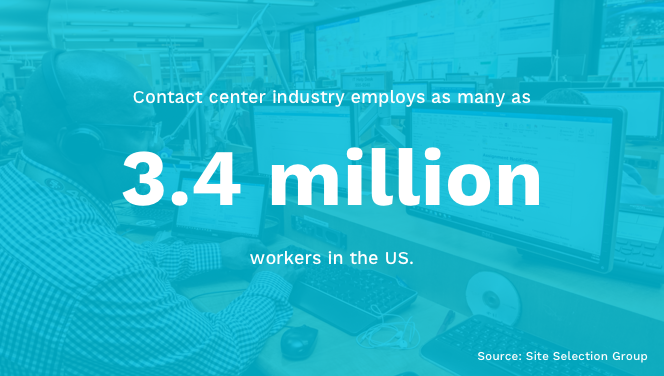The COVID-19 pandemic has hit many companies hard and caught them unawares. Why? Well, it’s not uncommon for businesses not to have all the policies and procedures in place to respond quickly to a worldwide crisis.
One particular area that employers, including contact centers, had to enforce near-on overnight was allowing staff to work from home.
However, many of them didn’t have a clear work from home policy or, indeed, any systems in place. In fact, loads of companies are still looking for advice on how to ensure their contact center employees stay safe and productive while working remotely.
In light of that, here are a few tips on what to include in your contact center work from home policy and how best to manage remote staff.
Let’s dive in!
What’s in?
Like what you see?
Don’t miss out. Subscribe to our quarterly digest to get the latest TA and TM resources delivered right to your inbox.
How do work from home policies help?
If your company has suddenly been thrown into disarray because of the recent changes, your employees may well be confused about what they can and can’t do.
Add to that any insecurity they may already be feeling about work as well as the whole situation around the impact of COVID-19 virus, and you have an unhappy workforce.
Therefore, any responsible employer or business is going to want to:
- Maintain productivity and morale levels
- Keep their profit margins intact
- Keep customer service levels high
- Set an organized working structure for their staff
This is where a robust work from home policy comes in handy.
It will help you streamline activities and the expectations required from your remote employees. It also provides clear guidelines and instructions on how to work most effectively from home so they (and your company in general) can continue to achieve their targets.
Contact centers, in particular, may be experiencing higher volumes of customer interaction. This will most likely be the case if you’ve been forced to close your physical stores and branches. Customers will still need to contact your company. So, it’s the role of your contact center workers to continue offering a high standard of customer service – irrespective of where they’re providing it from.
And a clear work from home policy can help steer them in the right direction.
Still unconvinced?
While the transition to working from home is challenging for contact centers, especially when they have to do it on a very short notice, it can also fast-track the digital transformation at your organization.
If your company is new to remote working or only allows it in extenuating circumstances, take a look at the research. A recent study by Flexjobs found that remote working can be beneficial for your business.
- 90% of employees said morale goes up with flexible working arrangements
- 85% of businesses said productivity increased as a result of flexible working arrangements including remote working
- 77% of companies reduce their operating costs when staff work from home
What’s not to love about these facts?!
So, if you’re writing your contact center’s work from home policy, below are some tips.
Your policy should include your part of the deal. In other words, what tools are you going to give employees to ensure they can work from home effectively? It should also set out the parameters of the policy and the communication channels and methods you’re committing to.

Contact center industry is a major employer in the United States.
1. Technical and security aspects
Giving call center agents the right tools to do their jobs will empower them and ensures valuable time isn’t wasted with unnecessary tech issues.
Remote access
One of the most vital things to do from the get-go is to ensure staff has access to your cloud system, ticketing system, CRM, knowledge base, and so on. If your contact center operates on a cloud-based system, your teams will need explicit instructions on how to access this and who to turn to if they encounter any problems.
As an employer, it’s your responsibility to communicate clearly with your workers and provide them with the info they need to perform their jobs well.
Adequate equipment
If you aren’t giving employees a business laptop, do they have hardware that’s compatible with your systems? Ensure all your employees have a stable and fast internet connection that’s secure.
You’re going to have to test this, so as part of your policy, ensure remote teams have the right equipment and know when you’ll be testing it. One way of diagnosing any potential problems is to use a systems diagnostics module for employers that helps you detect any issues remotely.
‘Adequate equipment’ may also extend to a webcam so that you and your virtual team can have more meaningful meetings and 1:1s. Nothing beats face-to-face communication, so using a video conferencing app like Zoom, Skype, WhatsApp, FaceTime, or Google Hangouts, is an absolute must.
You should also provide guidance on how to conduct daily backups.
Addressing cybersecurity risks
It’s your job to minimize any cybersecurity risks employees face as a result of remote working. Remember, your teams are often handling private and sensitive information about customers. Is that information safe? You need to ensure that:
- Cyber attacks are minimized
- Your employees comply with any security measures they need to take
For instance, can you instigate a ‘pop-up’ screen that teams see before they log off at the end of each day? The same when they log on again in the morning? This could display a quick-fire security checklist that reminds them of all the things they need to do to ensure they (and your company) stay safe online.

Beside compromising your customers’ information, data breaches are also expensive. That’s why you need to ensure cybersecurity when your employees are working from home.
2. Policy scope
Your policy should include details about when contact center agents are permitted to work from home.
For example:
- All the time
- Part-time
- In extraordinary circumstances (COVID-19)
- By request only
- In extreme weather
- To facilitate a better work-life balance
- Medical reasons
- Parenting
Your policy should also state if working from home is a permanent or temporary arrangement and also, how often you will review the policy.
As part of your policy, you need to establish the correct procedure for employees requesting to work from home. Some firms run this via HR, others via line managers who pass this onto HR. Either way, be clear about what the process is, so no one is confused.
It’s also crucial to specify whether or not working from home means worker’s employment terms are different. If they are, then you will have to offer remote workers new contracts.
3. Expectations and work schedules
You need to be transparent with your remote workforce about your expectations. By this we mean, what you want from them and at what times. Boundaries are still relevant and need to be set between work and home life.
People need to rest and recharge. However, there’s a delicate balance between telling everyone they have to work a straight 9 am to 5 pm shift, and allowing for breaks and flexible working. Determine how long in advance your employees will get their schedules, if there is any flexibility, if there are options to work overtime, how this would be compensated etc. Include guidelines regarding breaks.
You’ll also need to set any targets you need achieving, for example, numbers of tickets that need solving. That way, your employees will know exactly where they stand.

Is your scheduling going to change when transitioning to working from home? If so, how? Don’t forget to explain details of scheduling in your work from home policy.
4. Communication channels
Employees want and expect communicating clearly and regularly. In light of this, your home working policy should set out how you and your teams will communicate with one another.
This should include:
- Scheduling work rotas in advance so workers can plan their work and downtime
- Communicating clearly about tasks that need doing, thereby eliminating the need for to and fro emails
- Clear deadlines
- Establishing effective and transparent communication channels. Don’t just rely on email – you could also utilize apps like Slack, Trello, Zoom, etc. This is imperative because clear communication increases efficiency, understanding, and morale.
- Clear guidance on time off, breaks, overtime potential, and how this will be remunerated.
5. Leave policy
Be it COVID-19 or any other illness, your work from home policy should also refer to your sick leave policy. This should include details on what employees should do if they get sick and are unable to work. For example, do they need to contact their manager or let HR know? Do they need to provide a doctor’s note?
Include your general leave guidelines and make it clear what your employees need to do if they want to request time off.
6. Training
If you’ve already instigated a sudden working from home set-up because of COVID-19, you may not have had time to consider training.
If workers are having to use a different kind of software to facilitate working from home, or employees are unfamiliar with working remotely, they might need training.
Are there any virtual courses they can follow? If so, point employees in the right direction and make it a priority for them. That way, they can hit the ground running (the right way) from the get-go.
Don’t assume your workforce will automatically plug in their computers and go. They’re not machines and will need some level of support and education to facilitate their understanding. Remember, your workforce is human and should be treated as such.
As part of this training, provide teams with instant access to your working from home policy, so they can familiarize themselves with it.
Top Tip: Attach an FAQ section of anticipated questions at the end of the policy and contact details to a person they can connect with if they have additional queries.
7. Health and safety guidance
Your business insurance, such as workers’ compensation insurance, liability insurance, and/or small business insurance cover, typically protects workers when they’re on your premises. But what about when they’re working from home?
You’ll want some sort of coverage in place. Not only to protect yourself from compensation claims but to also show that you, as an employer, care about the health, safety, and wellbeing of your employees.
A remote workforce presents a more unique set of potential health hazards and risks you need to address in your working from home policy.
For example:
- Workers may not have ergonomic equipment at home
- They may not have a dedicated office space
- They may not have a secure Wi-Fi connection or VPN, leading to cyber risks
As such, your policy should include best practice expectations for your remote workforce while they’re working from home.
For example, you could suggest and promote the following:
- For remote workers to inspect their workspace to ensure it’s hazard-free. For instance, ensuring it’s a space where falls or trips are avoidable, and there are no fire or ventilation risks.
- For remote employees to create a dedicated and distraction-free workspace if possible.
- Encourage your remote workforce to test that all their equipment works (and operates at the required speed)
Remote workers must familiarize themselves with your company’s policy on preventing accidents in the workplace, wherever that workplace is.

Creating a checklist will make your health & safety guidelines more concrete to your contact center workers. Check out the complete checklist including electrical safety, workstation & other secruity measures here.
Where COVID-19 is concerned, your responsibility as an employer doesn’t end because your employees work from home. The health and safety part of your work from home policy should actively encourage remote workers to:
- Wash their hands regularly using soap and water
- Use 60% (or higher) alcohol-based hand sanitizer
- Limit social contact with others, be it social distancing or quarantine
- Not shake hands
- Cover their mouth with an elbow or tissue when coughing or sneezing
- Throw used tissues away
- Keep their equipment clean
A quick round-up
Many companies already have a home working policy with accompanying procedures in place. But, the current COVID-19 pandemic will have caught many firms unsurprisingly unprepared. If you want your contact center business to power through this crisis and potential other non-pandemic related incidents, a reliable home working policy is essential. In fact, it should be part of your employee handbook and induction.
If you want to embrace the digital transformation of your workforce, ensure you have all the right policies in place. That way, you won’t be lagging behind with a really confused and unmotivated workforce! Don’t wait for the next scary thing to happen. Be prepared!
- White paper
Before you continue!
Don’t forget to grab your free copy of our new whitepaper on the digital transformation of contact center recruitment processes. Learn about:
- The biggest challenges in contact center recruitment today and how to overcome them.
- The 4 pillars of Digital Transformation
A top BPO’s journey towards a digitally transformed recruitment procest



